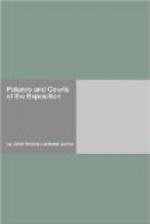The great cloud of blue smoke rises in increasing breadth and height thru the trees.
Don’t fail to notice the wonderful skies in these two canvases.
Water — On a portion of land between two waters men and women have sauntered down to the water’s edge to fill their jars. The flamingoes, birds of the water, stand in the foreground telling you that water is near. Plants grow luxuriantly on the banks. Pregnant clouds are blown nearer and nearer. The canvas is fairly moist with watery suggestions.
It would not be hard to realize when you look at this canvas that it was done by a man who understands the art of making stained-glass windows. He cannot keep his secret from you.
The second treatment of Water — Great brawny-armed fishermen are pulling in their heavy net. In the distance come men with baskets on their heads to carry away the wriggling fish. Beyond the trees the heavy moisture-laden clouds come nearer and nearer.
Air — A great windmill such as one sees in Frank Brangwyn’s etchings (for he lived during his youth in the windmill country, making what he saw around him his own).
The wind has brought the storm-laden clouds and the rain is descending. The currents of moisture-laden air are reflecting the rainbow. The wheat of the field bends far forward as the wind blows over it.
The belated harvesters (the foremost with his winnowing sieves) are blown forcibly along their path.
The many flowers bend their heads under the forward movement of the breeze. It is most interesting to notice how many devices have been used in order to make the work as suggestive as possible.
The second treatment of Air. The great trees are most noble in their strength.
Men, strong like the trees, are shooting thru the air their arrows.
A flock of frightened white birds are cutting the air, showing you why the men are there. This is a simple but clever treatment of the subject.
-
If you would know why you feel that there is something ancestral in these glorious compositions, why the strong colors are so well combined, why the canvases breathe freedom of thought and action, why the distances are so marvelously expressed, why the sky and water are just that deep wonderful blue, read Sparrow’s “Frank Brangwyn” and you will soon discover, and the appreciation for the pictures will be increased tenfold.
-
Now step down into the Cloister, so that you can see well Helios, the setting sun. This was the primitive man’s idea of the setting sun. He saw the sun as a man holding a huge golden ball, splashing down into the waters of the west. The serpent represents the burning sting of the sun.
You are bound to reflect here that the sun has thrown off great nebulous masses and that one of those masses has cooled and that we now call it the Earth. Yonder it is, seen at the end of the fountain, with four streams of water, from prehistoric sea life, playing over it.




